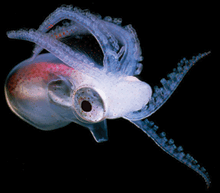 Okay, enough about the evolution of sex for now. I got some data again, but sadly discovered that I'd used the wrong selection for my third marker.
Okay, enough about the evolution of sex for now. I got some data again, but sadly discovered that I'd used the wrong selection for my third marker.Previously, I'd transformed Rd--the standard lab strain of Haemophilus influenzae--with MAP7 genomic DNA, which contains several antibiotic resistance alleles. The frequencies of transformation for the two markers I checked looked reasonable, and the frequency of double transformants exceeded expected (that is, in excess of the product of the independent frequencies).
Since the genes for the two resistances are near each other (linked), this was to be predicted, but I had no third unlinked marker to check how many cells in my competent cell prep were actually competent. If only a small fraction of cells in the culture were competent, the excess double transformants I observed could be spurious, rather than due to linkage.
To more accurately measure the linkage between the loci conferring Kan and Nov resistance, I repeated the transformation with frozen stocks of the same competent cells using a third selection for Spc resistance, which is encoded at a much more distant locus from the other two to act as a control. This involved plating to eight kinds of media: No antibiotic, 3X each individual antibiotic, 3X each double antibiotic, and all three antibiotics.
Sadly, I discovered yesterday that cell counts on the +Spc plates were quite similar to that of the no antibiotic plates, so there was not much selection for transformation at the unlinked locus. Sigh. I initially thought this was because my strain was already resistant to Spc, but then I remembered something Sunita told me: "Double check the antibiotic concentrations in the stock before adding it to the media. You don't always add the same amount." So this post could also be entitled, "Always listen to Sunita." I added 10-fold too little antibiotic to the +Spc media.
So instead of evaluating the fraction of my cells that were competent, I simply ended up repeating my previous experiment with a bunch of extra work. The bad news is that now I have to do it again. The good news is that my no DNA controls were perfectly clean and my technique appears to be somewhat reproducible:
Total viable cell counts were on the order of a billion per mL, and transformation frequencies looked like this, where blue bars illustrate the transformation frequencies for current experiment and red show the previous experiment (calculated as per Rosie's method):
 ...by no means flawless. The Obs/Exp ratios of double recombinants were 65 and 8 in the 2nd and 1st experiments, respectively. But the frequencies themselves were in the right order of magnitude. It is also possible that there are differences between fresh and frozen comptent cells. I might predict that the fraction of competent cells was reduced in the second experiment.
...by no means flawless. The Obs/Exp ratios of double recombinants were 65 and 8 in the 2nd and 1st experiments, respectively. But the frequencies themselves were in the right order of magnitude. It is also possible that there are differences between fresh and frozen comptent cells. I might predict that the fraction of competent cells was reduced in the second experiment.Just for good measure, I checked out whether spectinomycin had ANY effect. The ratio of + : - spectinomycin should be 1, if the antibiotic had no effect:
CFU / SpcR = 1.2
NovR / NovSpcR = 1.2
KanR / KanSpcR = 1.3
KanNovR / KanNovSpcR = 1.2
So it looks like maybe the Spc did kill some cells; it just wasn't a strong selection.
Try try again...

Any chance you could tell Franck to "Always listen to Sunita"?!
ReplyDeleteIn this context another word for 'spurious' is 'congression'. If not all the cells in your prep are competent, or if some cells are taking up more DNA fragments than others, this needs to be factored into the calculation of the expected frequency of double transformants. Conversely, if you know your markers are unlinked (e.g. SpcR is not linked to KanR or to NovR in a normal chromosomal DNA prep (fragment size 50-100kb)), you can use the deviation from expected double transformation frequency to calculate the fraction of cells taking up DNA.
ReplyDelete